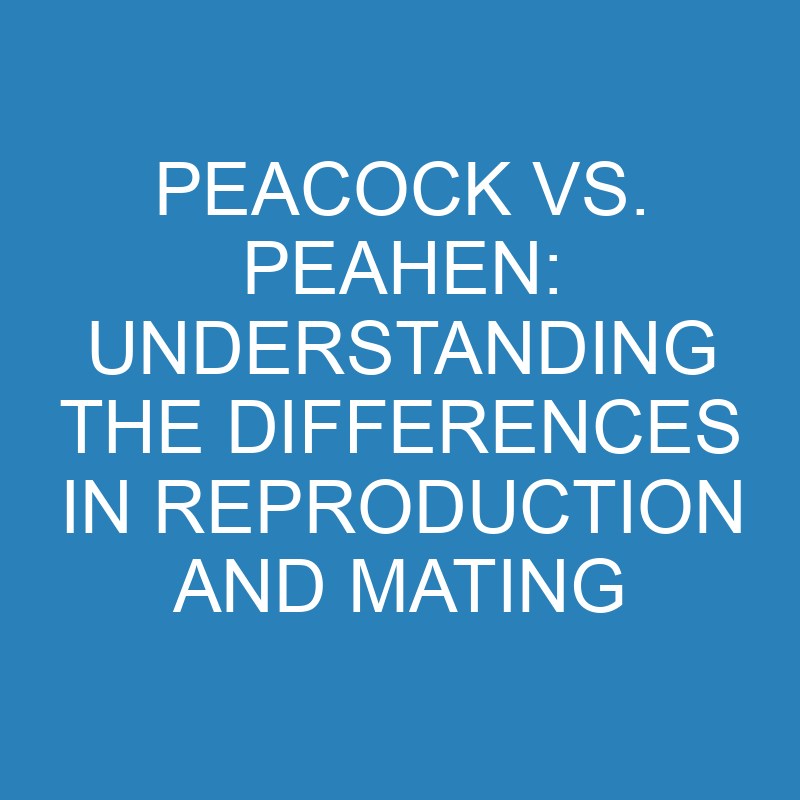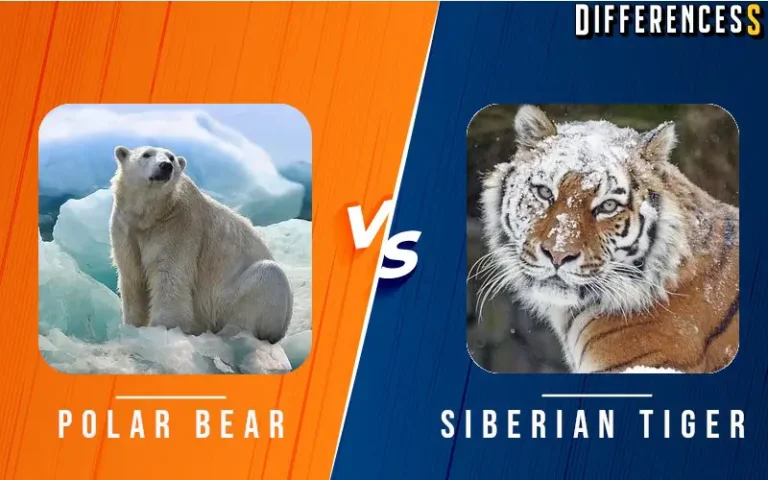
Peacocks and peahens are two majestic birds that are often associated with beauty and grace. However, despite their similar appearances, there are some key differences between these two stunning creatures. In this article, I’ll delve into the distinct characteristics that set peacocks and peahens apart. From their vibrant plumage to their behaviors and roles within their species, understanding these differences will give you a deeper appreciation for these remarkable birds. So, let’s take a closer look at the fascinating world of peacocks and peahens and uncover what makes them unique.
Post Contents
Physical Appearance
When it comes to the physical appearance, the difference between a peacock and a peahen is quite striking. The peacock, which is the male counterpart, is known for its dazzling and flamboyant plumage. Its most distinctive feature is its long, vibrant tail feathers, which are displayed in a stunning fan-shaped pattern during courtship. These feathers, called “train”, can reach up to six feet in length. The train is adorned with iridescent colors such as shimmering blues, greens, and purples, creating a captivating visual spectacle.
On the other hand, the peahen, being the female of the species, does not possess the same elaborate plumage as the peacock. Her appearance is more subdued and practical, allowing her to blend in with her surroundings and protect her young. While the peahen lacks the extravagant tail feathers, she still has a smaller crest on her head and feathers with subtle shades of brown and gray, providing her with camouflage to avoid potential predators.
An interesting fact about peafowl is that they are sexually dimorphic, meaning there are significant physical differences between males and females. This is in stark contrast to many other bird species where both genders look more or less the same. In the case of peafowl, the male’s striking appearance is a result of sexual selection. The extravagant display of the peacock’s feathers is intended to attract the attention and admiration of the peahens during the mating season.
The physical appearance of the peacock and peahen differs greatly. The peacock boasts a dazzling and flamboyant display of vibrant tail feathers, while the peahen possesses a more subdued and practical appearance. These distinct features highlight the sexual dimorphism in peafowl and add to the allure and intrigue of these magnificent creatures.
| Aspect | Peacock | Peahen |
|---|---|---|
| Plumage color | Vibrant iridescent colors | Subtle shades of brown, gray |
| Tail feathers | Elaborate and decorative | Absent extravagant feathers |
| Crest | Prominent | Smaller on top of the head |
Plumage Differences
When it comes to peafowl, the differences in plumage between peacocks and peahens are truly remarkable. The peacock, with its vibrant and flamboyant appearance, steals the show with its beautiful and intricate display of feathers. On the other hand, the peahen maintains a more subdued and practical look.
Let’s delve into the specifics. The peacock boasts a magnificent tail, commonly referred to as a train, which is a sight to behold. This train consists of long, iridescent feathers that are prominently displayed in a fan-like shape during mating rituals or courtship displays. The vibrant hues of blues, greens, and golds make the peacock an absolute showstopper, captivating the attention of any onlooker.
In contrast, the peahen displays an appearance that is more modest, yet equally remarkable in its own way. While she lacks the extravagant tail feathers of the peacock, her plumage is adorned with subtle shades of brown and gray. This understated coloration provides her with better camouflage and protection from potential predators, allowing her to blend into the environment and ensure the survival of her offspring.
The striking differences in plumage between peacocks and peahens are a result of sexual dimorphism. This means that there are significant physical variations between males and females within a species. In the case of peafowl, the elaborate plumage of the peacock is a product of sexual selection. During the mating season, the peacock uses his extravagant feathers to attract the attention and admiration of the peahens, showcasing his fitness and genetic superiority.
The plumage differences between peacocks and peahens are visually captivating and play a crucial role in the reproductive success of these magnificent birds. While the peacock dazzles with his vibrant and elaborate display, the peahen’s practical plumage ensures the survival of future generations. Understanding and appreciating these distinct characteristics adds to the overall awe and beauty of these remarkable creatures. So now, let’s further explore the behaviors and roles of peacocks and peahens within their species.
Behavioral Differences
Peacocks and peahens not only have distinct physical appearances, but they also exhibit different behaviors that set them apart. Here are some key behavioral differences between the two:
1. Mating Rituals: When it comes to attracting a mate, peacocks take center stage with their elaborate courtship displays. The male peacock will spread its magnificent train of feathers into a resplendent fan-like shape, vibrating them to create a mesmerizing visual and auditory show. Meanwhile, the peahen, being the more practical of the two, observes these displays and selects a mate based on the male’s display prowess and overall health.
2. Vocalizations: While both peacocks and peahens can vocalize, it is primarily the male that is known for its loud and distinctive calls. The peacock’s call can range from a high-pitched scream to a series of grunts and cries, which are often heard during their mating rituals. On the other hand, peahens have a more mellow and subdued call, which they use to communicate with their chicks and other members of their social group.
3. Feeding Behavior: Peacocks and peahens have different foraging strategies. Peahens, being responsible for incubating the eggs and caring for the young, tend to be more focused on finding food for themselves and their chicks. They often forage on the ground, searching for seeds, insects, and small invertebrates. Peacocks, on the other hand, have a broader diet and are more opportunistic feeders. They have the ability to perch in trees and shrubs to search for fruit, berries, and even small reptiles.
4. Socialization: Peacocks and peahens have different social structures. Peahens tend to gather in small groups called harems, consisting of one dominant male and several females. These harems exist primarily for mating purposes. Peacocks, on the other hand, are more solitary and tend to establish territories. They defend their territory against other males to ensure exclusive access to mating opportunities.
Reproduction and Mating Habits
When it comes to reproduction and mating habits, peacocks and peahens have some interesting differences. Let’s dive into the intriguing world of peafowl courtship.
1. Courtship Displays
Peacocks are famous for their magnificent courtship displays. During mating season, the male peacock will spread his train of feathers into a fan-like shape and vibrate them, creating a mesmerizing visual and auditory show. This display is not just for show-off; it is a way for the male to attract the attention of the peahens and demonstrate his fitness and genetic superiority. The more elaborate the display, the better chances of attracting a mate.
2. Mate Selection
The peahens carefully observe these courtship displays and choose their mates based on the male’s display prowess and overall health. They look for large, symmetrical, and vibrant feathers, as well as healthy body condition. This selection ensures that the offspring will inherit the best genetic traits from their parents. It’s survival of the fittest in the world of peafowl!
3. Calls and Communication
In addition to their stunning visual displays, peacocks and peahens communicate through calls. Peacocks are known for their loud, piercing, and distinctive calls, which can be heard from a considerable distance. These calls serve multiple purposes, including attracting mates, defending territory, and warning others of potential threats. On the other hand, peahens have a more mellow and subdued call, often described as a soft “kurr”.
4. Mating Behavior
Peahens tend to be more passive during mating. Once a peacock has successfully attracted a mate, he will perform a ritualized courtship dance, emphasizing his colorful feathers and displaying his feathers in an upright, fan-like position. If the peahen is impressed, she may respond by crouching down or quietly following the male. The male will then mount the female, and the mating process begins.
Conclusion
Understanding the differences between peacocks and peahens provides valuable insights into the fascinating world of these magnificent birds. Through their elaborate courtship displays, peacocks captivate the attention of peahens with their vibrant and majestic feathers. Peahens carefully observe these displays, selecting their mates based on the male’s display prowess and overall health. The distinctive calls of peacocks and the more subdued calls of peahens further distinguish these two genders.
During mating, the male peacock performs a mesmerizing courtship dance, showcasing his colorful plumage. If the peahen is impressed, she may respond by crouching down or quietly following the male, signaling her interest. This ritualized courtship dance and the subsequent mating process are essential aspects of their reproductive habits.
By delving into the unique characteristics and behaviors of peacocks and peahens, we gain a deeper appreciation for their beauty and complexity. These remarkable birds continue to captivate our imagination and remind us of the wonders of the animal kingdom.
Frequently Asked Questions
Q: What are the differences between peacocks and peahens?
A: Peacocks and peahens have distinct physical differences. Peacocks are males and have vibrant and colorful feathers, especially in the train or fan-like shape. Peahens are females and have more subdued feathers. Additionally, peacocks have elaborate courtship displays and loud calls, while peahens have a mellow call.
Q: How do peacocks attract peahens?
A: Peacocks attract peahens through their elaborate courtship displays. They spread their train of feathers into a fan-like shape and vibrate them to catch the attention of peahens. Peahens carefully observe these displays and choose their mates based on the male’s display prowess and overall health.
Q: What happens during peacock mating?
A: During peacock mating, the male peacock performs a ritualized courtship dance, emphasizing his colorful feathers. If the peahen is impressed, she may respond by crouching down or quietly following the male. The male then mounts the female, and the mating process begins.
Q: Why is understanding peacock mating important?
A: Understanding peacock mating is important because it adds to the overall understanding and appreciation of these remarkable birds. It provides insights into their reproductive habits and helps researchers and enthusiasts understand their behavior and ecology better.






